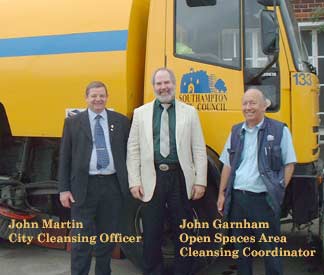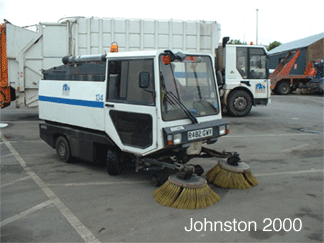Southampton:
City of Contrasts, City of Change
by Ranger Kidwell-Ross
As I review the following story I've just written, it's clearly a saga consisting of two parts. The first part includes information about how one city is handling its street and associated area cleanup: its specific challenges, the equipment it uses, and how it gets the job done. The second part reflects the city's reaction to being introduced to a new type of sweeping technology -- regenerative air -- and the hopes of all those involved that it will change the way sweeping is done in Southampton. As with any new technology, only time will tell. However, given the way the environmentally-friendly regenerative air systems have swept the U.S. and Australia markets, I'll be surprised if the U.K. doesn't embrace the same winds of change, as well.

For a variety of reasons, Southampton City Council faces a tough challenge in keeping its approximately 840 curb miles clean. Fortunately, due to the commitment of Council managers to pursue an aggressive and innovative campaign of improvement, the city appears to be well up to the task.
Having been devastated by bombings during World War II, Southampton is a mix of the old and the new. Although there are core areas of older buildings, most have been replaced with newer construction in the past 50 years. Streets of the city are, overall, in relatively poor condition due to the ravages of time and the irregularities caused by frost damage. These two factors create difficulties in keeping the streets clean, because it's hard to keep plants from growing in the pavement cracks, and the uneven pavement makes any sweeper's job more difficult. Southampton is also a well-known seaport, so it faces the additional challenges associated with docks and shipping.
Because Southampton's streets are relatively narrow and usually have cars parked on both sides, many of the sweepers are smaller units with a high degree of maneuverability. Smaller machines also allow the operator to drive up onto the sidewalk -- called "footpaths" in England -- in order to clean those areas. This is what is called "precinct sweeping." In recent years, as the city has moved to increased mechanization, they've added larger sweepers to take care of the major streets.

As part of their generous hospitality to our effort to learn about their sweeping operation, I spent time with three members of the Council's management team, all named John (or Jon). As a result, I'm using their last names to identify which was which -- I hope I've kept good track! I was also treated to a delightful and delicious lunch in the employee lunchroom, and engaged in conversation with several of their sweeper operators. (I heartily recommend Wendy's beef and tomato soup to anyone who's passing nearby!)
There to greet me was John Garnham, the Council's coordinator for Open Spaces Area Cleansing. "Although the Council used only Johnston sweepers for many years," Garnham told me, "our current mix of smaller machines consists of 7 Schmidt Swingos, 2 Scarab Minors and a Johnston 2000. For road sweepers, we have 2 Johnston 600s and a Schorling that's basically a copy of the Johnston design. [They originally bought three Johnston 600s but, three years ago, one was replaced by a Schorling -- for reasons a driver named Simon will explain a little further along.]

"A lot of the side roads in Southampton are car parks," said Garnham, referring to the lack of parking throughout the city. That's because, when the city was rebuilt after the war, provisions were made for only one car per household. Today the average is more toward two and, like in most urban areas, zoning has moved toward denser housing.
"There's no sense putting any sort of really big machine in there," he continued. "The smaller ones can get in, whereas the bigger ones can't do the job because of the angle that has to be taken to get in and out of where the cars are parked. Fortunately, since our debris-dump depot is right close to the center of town, it's no problem for the small machines to unload fairly frequently."
About 10 years ago, Garnham explained, the Council was first required to bid out its sweeping services. The in-house sweeping program put together a bid in an attempt to keep its job, competing against 32 other entities wanting to win the contract! A few bids came from companies as far away as Italy. Proudly, the Council program won the bid to keep performing its own sweeping. Five years later, when the contract was required to be re-bid, they won again. That time, only three other companies bid against them since they'd proven so competitive the first time.
Now, the law has been changed to make Southampton a "best value local authority." This means they are no longer required to keep going out to bid, but their program is checked on a continuous basis by other agencies to ensure efficiency and quality. They are also subject to regular audits, and have to maintain the prescribed standards or the sweeping program can be taken away from the Council.
Swept debris is dumped in an area at the Council depot, where recyclables and other miscellaneous appliances, etc., are stored for eventual disposal. Many of their sweepers can also tip into vehicles, if need be. The dumping area is regularly checked by an environmental agency, and if the city lets a buildup accumulate, or if anything else is found amiss, the agency can take away Southampton's ability to dispose of its own debris, since an EPA license is required for operation.

Next I spoke with Jon Dyer-Slade, Open Spaces Manager for Southampton. He discussed what might be called 'the big picture' of how the city is monitoring its focus to adapt and prosper in current times. "We want to look at all the different aspects involved in cleaning up Southampton," said Dyer-Slade. "We're engaging the community to do its part, from not dropping stuff in the first place to helping keep areas clean. Where we can make an impact is in how we do the cleanup.
"We have our city in a condition now where we're scoring in the high 90s for cleanliness standards. We've moved up from the high 80s, which is where we were two years ago. This score is based on having a random percentage of our roads checked on a daily basis. We check to see if there is 'no litter at all,' 'small amounts of litter,' 'small accumulations of litter,' or 'large accumulations of litter.' The first two are graded 'A' and 'B,' and obviously what we want are all 'A's.
"People drop litter, bags split open and so forth, so there is always going to be some amount of litter around. The difficult part is that when you've made it into the mid-'90s, any extra percentage is very hard to achieve. And you only need a little bit of a problem to knock it all back. Our roads are obviously where the focus needs to be now. I think [the environmental side] is going to become a bigger issue in the next few years."
John Martin, City Cleansing Officer for Open Spaces, joined us in the conference room, and he talked to us about some of the general issues Southampton faces. "We sweep every road with a minimum frequency of 4 weeks, including all residential areas," Martin said. "The major trunk roads are swept more often, the main arteries on at least a weekly basis, and the downtown center is done daily. We coordinate our precinct sweepers with the road sweepers to provide the best results.
"Unfortunately, many of our roads are not in very good condition and, as a result, are harder to sweep. We think these new sweepers will do a better job, and this will help keep our roads in better condition, since there will be less damage from plants growing in the cracks. When we get rid of all the detritus, we won't have to spray as much, either.
"Southampton is quite a compact city. It has a lot of areas that were developed post-war, because of the heavy bombing damage it suffered. However, since the parking provision required at that time was for one car per household, now, on many of our streets, we have no place to put cars in order to sweep the roads. We're a university town, so there's a large influx of students. In multiple application areas, where many of them live, you might have four students per house and all of them have a car. We use two men with backpack blowers, because in some places that's all you can do. Unfortunately, we're having to encroach on some of our green areas in order to put in car parking. That's something no one wants to do."
Every day, the Council computer randomly selects sections of streets that are then checked for cleanliness. These are not entire streets, but specific segments of a street. That's how the grading (discussed above) is done, by checking random sections on a daily basis.
The federal government has encouraged EnCams, which stands for Environmental Campaigns [http://www.encams.org/] to review how cleanliness monitoring is performed. They're the primary organization that's overseeing environmental cleanliness. EnCams has worked with the government departments in the U.K. to re-evaluate how they look at litter. And, the result is to not just look at litter, but to evaluate detritus of all types.
Another service the Council offers is car and truck inspection that must, by law, be performed every two years. For commercial vehicles, it's performed every year. It's quite a thorough inspection, and a way of assuring vehicles on the road will be safe. The MOT service also provides income to the Council. It's a service the Council has to bid on, and similarly has to bid on doing its own mechanical work on its equipment fleet.
Although not exactly related to sweeping, the way Southampton handles its graffiti removal is very state-of-the-art. When graffiti is discovered, on a building or elsewhere, a Council officer is dispatched to take pictures of it with a GPS-enabled digital camera. The camera sends the photos, along with the physical address of the graffiti, directly to the contractor responsible for its removal. "Most of the graffiti artists sign their 'art' with a 'signature tag,'" Martin told me. "Since we're now compiling this data, if we eventually catch the guy, we'll have detailed information and photos for use as evidence. We can show the location, date, and everything else, so they can't normally wriggle out of it." The system also ensures that graffiti is removed in a timely fashion.
The Southampton management struck me as a group that has its eyes wide open as they roll into the future. They appear progressive, competent, and interested in improvement wherever they can find it. Equally important, they know the value of involving members of their entire organization in the process.
Southampton sweeper operators exhibited a camaraderie that only develops from being treated well and enjoying one's work. Because I had the opportunity to have lunch with some of the sweeper operators, I was treated to a few of their personal stories. One is a humorous recount -- well, in retrospect, anyway -- about one of those quirky things that can happen while driving a sweeper.
As Southampton Council becomes increasingly faced with the many difficulties the future is bound to hold, my guess is its citizens are in good hands. Southampton, a city with a rich history, also appears to have a bright horizon.
This story was one written during our editor's trip to Europe in 2003 to investigate how sweeping was done on that continent. While he was there, Ranger wrote an online journal for the sweeping industry. You may still view this online journal, which won a Grand National APEX Award for Online Journalism in 2004, in our archives.
|

